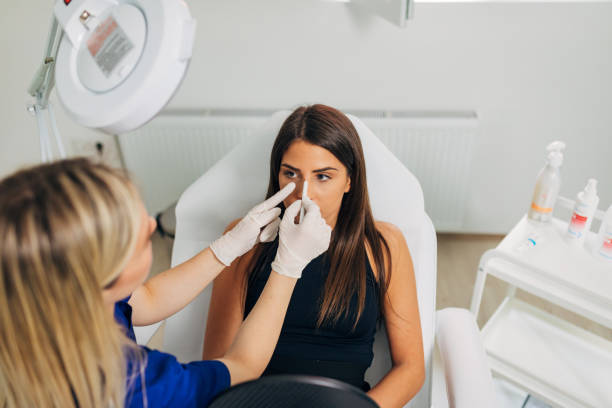Rhinoplasty, commonly referred to as a nose job, is a popular cosmetic procedure aimed at enhancing the appearance and functionality of the nose. It is a transformative surgery that can significantly boost self-confidence and improve facial harmony. When considering Rhinoplasty in Abu Dhabi or elsewhere, one common question that arises is: What is the ideal age for rhinoplasty? Understanding the appropriate age for this procedure is essential for ensuring optimal results and safety.
Understanding Rhinoplasty and Its Purpose
What Does Rhinoplasty Involve?
Rhinoplasty involves reshaping or resizing the nose to better align with an individual’s aesthetic goals or to correct functional issues such as breathing difficulties. The procedure can address a variety of concerns, such as a prominent hump, asymmetry, or a crooked nose. It is suitable for both cosmetic enhancement and medical correction.
Who Typically Seeks Rhinoplasty?
Individuals seeking rhinoplasty are often motivated by a desire to improve facial symmetry, correct congenital deformities, or repair injuries. While it is popular among adults, the procedure can also be performed on teenagers, provided they meet certain physical and emotional maturity criteria.
Factors Influencing the Ideal Age for Rhinoplasty
Physical Maturity and Facial Development
One of the primary considerations for determining the ideal age is physical maturity. The nose continues to develop during adolescence, and performing rhinoplasty prematurely may interfere with natural growth. Generally, the procedure is recommended after the facial bones have fully matured to ensure stable and predictable results. This maturity typically occurs around the age of 16 to 18 for females and slightly later for males.
Emotional and Psychological Readiness
Beyond physical maturity, emotional stability and realistic expectations are crucial. Candidates should have a clear understanding of the procedure, its limitations, and potential outcomes. Age alone is not sufficient; psychological readiness ensures that patients are making informed decisions and are prepared for the recovery process.
Personal and Cultural Factors
Cultural perceptions of beauty and individual aesthetic goals also influence the timing. Some individuals may choose to undergo rhinoplasty at a younger age due to personal reasons, while others prefer to wait until they are fully mature.
Recommended Age Range for Rhinoplasty
Adolescents and Teenagers
Many surgeons recommend performing rhinoplasty on teenagers after they have reached a certain age, typically around 16 to 18 years old. At this point, the nose has usually reached near-adult size and shape, minimizing the risk of future changes.
Adults
For adults, there are no specific age restrictions. As long as an individual is in good health and emotionally prepared, rhinoplasty can be safely performed at any age beyond adolescence. Older adults may also undergo rhinoplasty to address age-related changes or restore facial harmony.
Special Considerations for Younger Patients
Growth Plate Concerns
Performing rhinoplasty before complete facial growth can lead to unpredictable results or the need for revision surgeries. Surgeons carefully assess growth plates and facial development before recommending the procedure for teenagers.
Psychological Assessment
Younger patients should undergo psychological evaluation to ensure they have realistic expectations and are emotionally prepared for the procedure and recovery.
Benefits of Timing Rhinoplasty Appropriately
Achieving Natural and Long-lasting Results
Waiting until facial growth is complete allows for more permanent and natural results. It reduces the likelihood of needing revision surgeries later on.
Ensuring Safety and Satisfaction
Proper timing minimizes complications related to ongoing facial development and ensures that the patient’s expectations are aligned with achievable outcomes.
Preparing for Rhinoplasty
Consultation and Evaluation
A thorough consultation with a qualified surgeon involves discussing aesthetic goals, medical history, and physical examination. This helps determine the most appropriate timing and approach.
Setting Realistic Expectations
Understanding the limitations and potential outcomes of rhinoplasty is essential. Patients should communicate their goals clearly and have realistic expectations about the results.
Preoperative and Postoperative Care
Preparation includes following preoperative instructions, such as avoiding certain medications, and planning for postoperative care to ensure optimal healing and satisfaction.
FAQs
1. At what age can teenagers undergo rhinoplasty?
Teenagers are typically considered suitable candidates for rhinoplasty after they have reached about 16 to 18 years of age, once facial growth has largely completed.
2. Can rhinoplasty be performed on older adults?
Yes. Age is generally not a limiting factor for rhinoplasty in adults, provided they are in good health and have realistic expectations.
3. Is there an ideal age for functional rhinoplasty?
Functional rhinoplasty, aimed at improving breathing, can be performed at any age once the individual is physically mature and emotionally prepared.
4. How do I know if I am emotionally ready for rhinoplasty?
Emotional readiness involves understanding the procedure’s limitations, having realistic expectations, and being psychologically stable. A consultation with a qualified surgeon can help assess this readiness.
Final Thoughts: When Is the Right Time?
The ideal age for rhinoplasty varies based on individual development, emotional readiness, and personal goals. Generally, waiting until facial growth is complete—around 16 to 18 years old for females and slightly later for males—is recommended for optimal results. For adults, age is less restrictive, making rhinoplasty accessible at various life stages.
